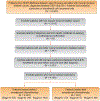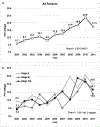Discerning Patterns and Quality of Neoadjuvant Chemotherapy Use Among Patients with Muscle-invasive Bladder Cancer
- PMID: 31411998
- PMCID: PMC8362849
- DOI: 10.1016/j.euo.2018.07.009
Discerning Patterns and Quality of Neoadjuvant Chemotherapy Use Among Patients with Muscle-invasive Bladder Cancer
Abstract
Background: Neoadjuvant chemotherapy is underutilized in bladder cancer patients who undergo radical cystectomy. However, the quality of regimens used in this setting remains largely unknown.
Objective: To determine utilization treatment patterns and survival outcomes according to regimens administered.
Design, setting, and patients: We used the Surveillance, Epidemiology and End Results (SEER)-Medicare linked database to identify patients diagnosed with clinical stage TII-IV bladder cancer from January 1, 2001 to December 31, 2011.
Outcome measurements and statistical analysis: Temporal trends were assessed using the Cochran-Armitage test. Multivariable logistic regression models were used to identify predictors for neoadjuvant chemotherapy use. Cox proportional hazards models were used to compare overall survival according to regimens administered.
Results and limitations: Of 2738 patients treated with radical cystectomy, 344 (12.6%) received neoadjuvant chemotherapy. The agents most commonly used were gemcitabine (72.3%), cisplatin (55.2%), and carboplatin (31.1%). The regimens most commonly used were gemcitabine-cisplatin (45.3%), gemcitabine-carboplatin (24.1%), and methotrexate, vinblastine, doxorubicin, and cisplatin (M-VAC; 6.7%). Use of neoadjuvant chemotherapy more than tripled during the study period, from 5.7% in 2001 to 17.3% in 2011 (p<0.001). The quality of the regimen administered impacted survival outcomes, as M-VAC use was significantly associated with better overall survival among patients diagnosed with stage II bladder cancer (hazard ratio 0.24, 95% confidence interval 0.07-0.86; p=0.030]. Limitations include the limited ability of retrospective analysis to control for selection bias.
Conclusions: Neoadjuvant chemotherapy was underused, and the quality of neoadjuvant chemotherapy regimens administered for bladder cancer was inconsistent with guideline recommendations. These findings are important when interpreting population-based data on the use of chemotherapy and extrapolating survival outcomes.
Patient summary: In a large population-based study, 12.6% of patients undergoing radical cystectomy for bladder cancer received neoadjuvant chemotherapy, half of whom received guideline-recommended regimens. The quality of the regimen impacted survival outcomes, as use of cisplatin-based chemotherapy was significantly associated with better overall survival among patients diagnosed with stage II bladder cancer. However, <1% of radical cystectomy patients received this regimen.
Keywords: Bladder cancer; Epidemiology and End Results; Medicare; Neoadjuvant chemotherapy; Quality; Radical cystectomy; Surveillance.
Copyright © 2018 European Association of Urology. Published by Elsevier B.V. All rights reserved.
Figures




References
-
- Siegel RL, Miller KD, Jemal A. Cancer statistics, 2017. CA Cancer J Clin 2017;67:7–30. - PubMed
-
- Clark PE, Agarwal N, Biagioli MC, et al.Bladder cancer. J Natl Compr Cancer Netw 2013;11:446–75. - PubMed
-
- Witjes JA, Lebret T, Comperat EM, et al.Updated 2016 EAU guidelines on muscle-invasive and metastatic bladder cancer. Eur Urol 2017;71:462–75. - PubMed

